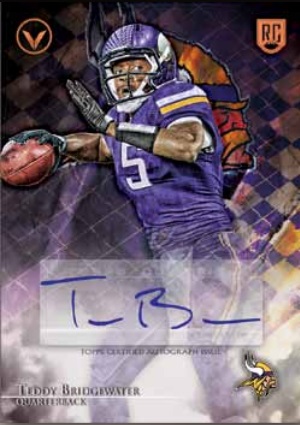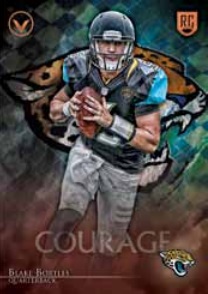When it comes to buying packs (and/or boxes) of sports cards, every sports card collector knows they are taking a risk. That risk is the possibility you'll get nothing of extraordinary value in that pack -- like all base cards. Of course, on the other hand, there is always the possibility you might get something totally awesome like a $200 hit. More often than not, you'll end up getting less money back than what you paid. That's just the name of the game. We all know of that risk, and accept it when we buy products.
But one such product takes this risk way above and beyond what I think is reasonable. That product is 2014 Leaf Best of Football Unopened Edition. (Currently priced at $155 on Blowout Cards as of April 25, 2014.)
In this product you get one cut autograph which is slabbed by BGS, and one sealed football box. At first thought this product might not seem so bad or so different from buying a hobby box of football cards yourself as you might do every few weeks or every month, but I think it is.
When you choose to buy yourself a hobby box of football cards, you tend to buy what you want and what you like. Why buy a hobby box of a product whose design you hate? By choosing a hobby box of a product you like you are ensuring that you're getting a product you like. This choice is a benefit to you as a consumer.
If you're like me, when you buy a hobby box of football cards, you may also tend to avoid products which have expired redemptions. Not all companies honor expired redemptions. Upper Deck and Topps will not honor expired redemptions, but Panini will. If you're concerned that you might get a hit which is expired and will not be honored by the company that produced that product, then you should avoid that product. The choice to choose which product to buy in order to avoid expired redemptions is another benefit to you as a consumer.
When you buy a box of 2014 Leaf Best of Football Unopened Edition, you give up both of those benefits. You don't get to choose which football box you're going to get, thereby running the risk of getting a product you hate. You also run the risk of getting a football product which has expired redemptions which will not be honored.
In my opinion, losing those two benefits is enough to make me not buy 2014 Leaf Best of Football Unopened Edition.
Now, I know some people might be thinking that there are some benefits to buying this product. I suppose there are. Like any other packaged sports card product, you have the chance at hitting some great cards and getting back more money that you paid for the box. For example, maybe your cut autograph will be Dan Marino. If it is, that is awesome! And maybe the football box you get is Topps Five Star Football, Upper Deck Exquisite or Panini National Treasures -- all very expensive hobby boxes which cost more than the $155 you spent to buy the Leaf Best of Football Unopened Edition Box. More than likely though, you're not going to get a National Treasures box.
One of the box breakers I use frequently (Breakerz Anonymous) did a
very nice analysis on the "recover rate" -- the amount of money you'd expect to recoup when you buy a box of 2014 Leaf Best of Football Unopened Edition. He watched all the available case breaks for this product on YouTube, crunched some numbers, and estimated that the "recovery rate" is 62.1%.
In other words, if you spend $989.95 buying a case of 2014 Leaf Best of Football Unopened Edition, you will on average lose $375.34 for opening it
just to see what football boxes and cut autographs are inside.
That figure does not take into account what may be inside the actual football boxes themselves. Once you open up those football boxes you are likely going to suffer another loss of money as the value of the cards in that box, on average, will not cost more than the value of the sealed box.
Imagine the level of frustration you would have if you paid $155 for a box of 2014 Leaf Best of Football Unopened Edition, you open it up, your cut autograph only worth about $20, and your unopened football box instead was 2013 Topps Magic (Blowout price of $51). Talk about a brutal punch to the gut. If you open up that box of 2013 Topps Magic, you're probably only going to get $20 worth of cards in return on average. So at the end of the day, after spending $155 for a box of 2014 Leaf Best of Football Unopened Edition you could be left with a $20 cut autograph and $20 worth of cards. That's a "recovery rate" of 25.8%.
One guy on the Blowout Cards forums said he paid close to $200 for a box of this product, got a Joe Schmidt cut autograph ($5 to $10), and his sealed football box was 2010 Topps Chrome Football ($65 on Blowout). He opened up the Chrome box and didn't even get an autograph! Things might not have been so bad had he pulled a Tim Tebow, Sam Bradford, or Dez Bryant base rookie card but he didn't even get any of those guys either! In total, he probably had around $15 worth of cards in the end. That's a "recovery rate" of 7.5%.
That last anecdote was a brutal one, and probably one of the worst ones you'd see. Could anything be worse than that? Yeah. How about getting a product full of expired redemptions. I couldn't find the tweet or post, but I remember seeing one guy complaining about getting an old Upper Deck product, ended up getting a redemption for a high valued card, but that redemption was expired! (Upper Deck does not honor expired redemptions.) So this guy basically had a "recovery rate" of 0% from the football box. I can't remember who exactly he got for his cut autograph but it wasn't anyone super valuable.
Frankly, I don't know why people buy this product. I'm guessing people just don't think enough about all the product's risks. If they did, I think they would realize that the risk is just way too much to endure. The possibility of getting a product you hate makes it risky. The possibility of getting a low-value sealed football box makes it riskier. And then the possibility getting a product with expired redemptions makes it insanely risky.
I don't blame Leaf for making this product, but as a consumer I'd stay far away from this product and would never buy a box of it for myself.













